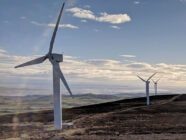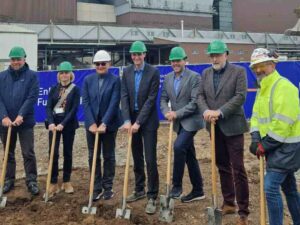
Panu Virolainen, chief technology officer at ABB Motion, discusses three real-world examples where R&D has helped drive decarbonisation and energy efficiency.
Research and development (R&D) is essential in achieving the world’s decarbonisation goals, writes Virolainen. It both introduces new technologies to the market and continuously improves existing ones.
In this way, R&D drives both energy efficiency and decarbonisation efforts, presenting cost-effective ways to reduce global greenhouse emissions and overcome integration challenges.
Though the technologies required to meet our climate goals already exist to a large extent, the main challenge is adoption. Especially, new digital solutions are also helping businesses make the right decisions for the planet.
Have you read?
ABB and Gravitricity partner on gravity energy storage systems
‘This is the decade of energy efficiency’ says Baker Hughes boss Simonelli
Innovation in motor technology
There are over 300 million industrial electric motors in use worldwide and they account for more than 45 percent of global electricity consumption. On top of this, the number of motors is expected to double by 2040.
Therefore, R&D that improves the efficiency of electric motors is critical. In fact, the International Energy Agency (IEA) advocates for tripling the investment in energy efficiency within this decade to achieve net-zero emissions. If existing motors around the globe were replaced with high-efficiency versions, the IEA has estimated that global electricity usage could be cut by as much as 10 percent.
Many industrial motors in action today use outdated inefficient technology – many are IE1 or IE2 designs (where an increasing IE number relates to a greater efficiency). The EU Ecodesign requirements call for motors between 75 kilowatt (kW) and 200 kW to meet the IE4 level as of July 2023.
However, ‘ultra-premium’ IE5 motors are already commercially available. These advanced motors use up to 50 percent less energy and can be designed without the need for rare-earth metals. Increasingly efficient tech and high energy prices have meant that businesses can rapidly recuperate the cost of investing in more efficient motors – in months rather than years.
There are also emissions associated with building new motors. So, a recent focus for innovation in this area has been on producing high efficiency synchronous reluctance motors (SynRM) that not only match the performance of traditional options but also, for example, eliminate the need for rare-earth metals.
Eco-friendly materials can be incorporated in other ways, too. One example of the progress made in this area is ABB’s prototype sustainable IE5 motor. This features a stator housing made from 100 percent recycled aluminium alloy and low carbon bearings with a 70 percent lower CO2 footprint than standard bearings. The result is an overall reduction in carbon footprint of 20 percent, equivalent to the CO2 produced by driving a passenger car for 500 km.
On test, the demonstrator motor has matched the performance of a standard SynRM model, highlighting that circular design does not need to have an impact on how the motor works.
ABB is going one step further with the SynRM motor by modelling additional sustainable alternatives with materials and components that have the potential to offer even greater savings. For example, in addition to the low-carbon bearings, adopting low-carbon copper will reduce the motor’s carbon footprint by another 10 percent.
Ultimately, the motor could also incorporate low-CO2 electrical steel (e-steel). This e-steel is important for efficiency and could potentially reduce the CO2 footprint by a further 30 percent. That is a total of nearly 60 percent CO2 footprint reduction, with no impact on performance and only a moderate increase in cost.
Stabilising power grids for a renewable future
R&D also provides new and revised technologies that support the integration of renewable energy sources. One example is synchronous condensers (SCs).
One example of how SCs are applied is the Lister Drive project in Liverpool, UK. The UK’s drive to reduce carbon dioxide emissions and minimise climate change is driving the increased use of renewable energy. The challenge is that wind and solar energy sources use power conversion technologies that do not provide the inertia that grid operators rely on to maintain grid stability.
To combat grid instability, renewable energy provider Statkraft, has installed two SCs. These simulate the inertia of traditional coal or gas-fired generators, providing an alternate source for stabilising the grid – which is essential for the UK’s shift from fossil fuels to renewables. This will help National Grid meet its target of operating a zero-carbon electricity system by 2025.
Notably, Lister Drive has introduced the world’s first high-inertia SCs. This design combines a 67 megavolt amps reactive (MVAr) SC with a massive 40-tonne flywheel, increasing the instantaneously available inertia by 3.5 times. This supports the national grid by providing reactive power compensation and additional short-circuit power capacity, allowing more renewables to be connected to the grid.
The system is currently operational and will meet around one percent of the UK’s need for grid stability by 2025. To ensure around-the-clock availability for this vital system, Statkraft has signed a 10-year services contract.
Also of interest: How to win the Home Energy Management business battle
ABB’s UK field service team will provide a full range of maintenance services, both planned and quick response. A full suite of digital condition monitoring solutions will be deployed to optimise performance and predict maintenance needs. By assessing real-time data with cloud-based analysis, the team can plan corrective actions before issues occur, ensuring system reliability.
Similar SC systems have been deployed in remote grid networks in Australia, Scotland and Canada. R&D success in the Lister Drive project has shown that this technology can help integrate more renewable energy into larger power grids.
Digital solutions for energy efficiency
As many technologies for a greener future exist, the main challenge is to make sure it is adopted widely and quickly. For example, a 2022 ABB survey found that over 95 percent of industrial businesses are willing to invest in energy efficiency, but less than half feel they have enough information to take action.
So, R&D has also provided new digital solutions that enable better decision-making when it comes to saving energy and costs. Digital energy audits, for example, enable industrial businesses to pinpoint exactly where the best places for energy-savings are across whole fleets of motors. An audit starts by gathering performance and efficiency data from motors, then checks it against what could happen if it was upgraded to be more efficient. The audit then shows energy and emissions savings and return on investment (ROI) if each motor were upgraded.
Take Tarkett, for example. The Swedish flooring manufacturer underwent a digital energy audit. It revealed that upgrading just 10 motors to high-efficiency technology could increase their energy efficiency from 80 to 95 percent. This resulted in an energy saving of 800 MWh annually – that is the equivalent to charging 68 million smartphones.
These advances emphasize the reason why a major share of ABB’s R&D team focus is on software and digitalisation: digital technologies will be a critical lever in pushing sustainable industry practices.
Building R&D skills and knowledge
Ultimately, climate change is not a problem that one company or person can solve. And, although many technologies required to combat climate change exist, they need to be quickly adopted and continuously developed to improve their competitiveness.
So, R&D is just as much about people as it is about technology. The key is to invest in those people to develop the new skills required in the energy transition, as well as share innovative ideas and methodologies.
Addressing the climate challenge requires putting together the top minds across business, customers, universities and even competitors. So, ABB founded the Energy Efficiency Movement in 2021. Joining requires a public commitment to enhance energy efficiency and provides access to a forum that facilitates knowledge sharing among all participants, including rivals. This underscores a dedication to the advancement of society and combating climate change.








